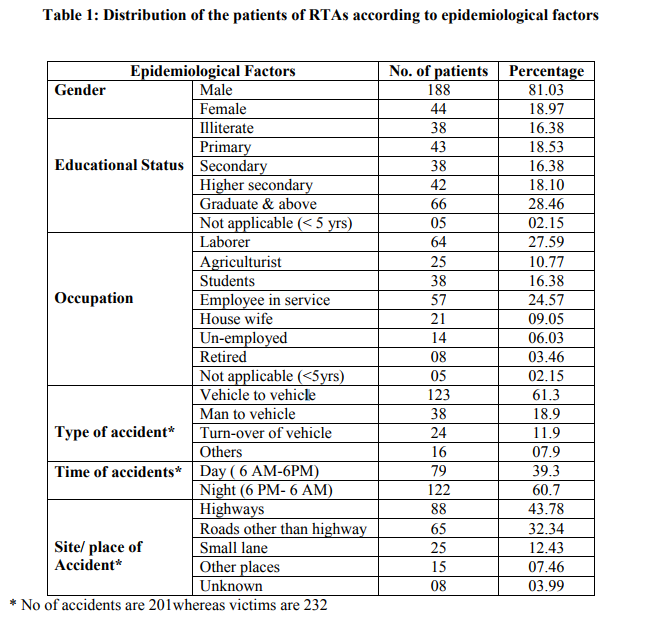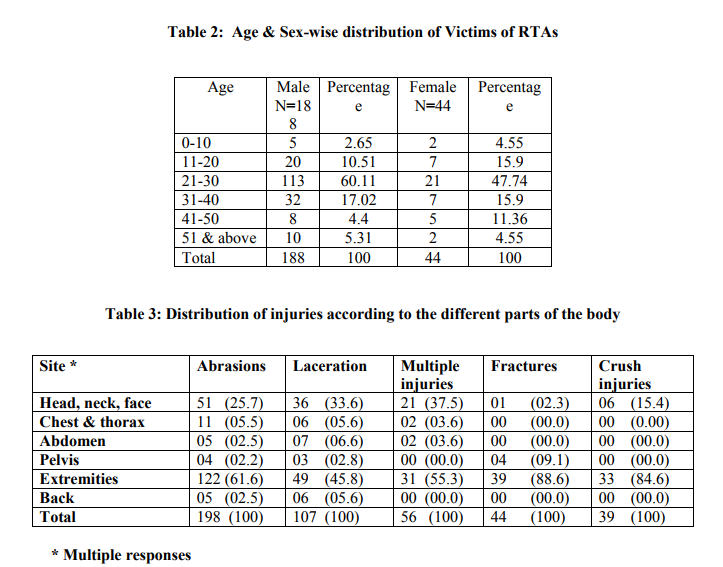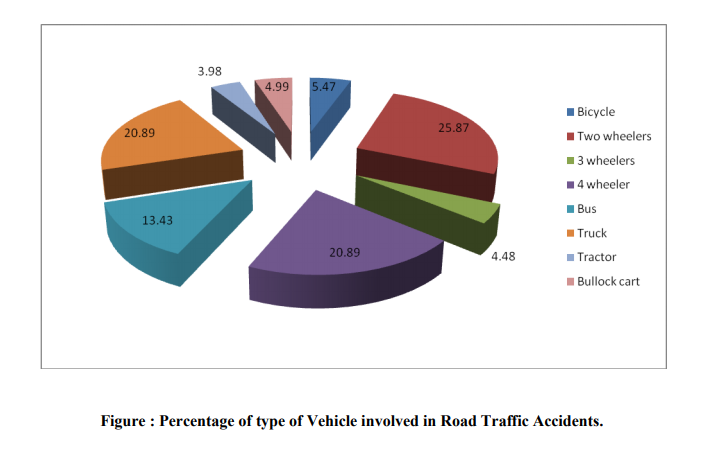IJCRR - 2(6), June, 2010
Pages: 13-20
Print Article
Download XML Download PDF
AN EPIDEMIOLOGICAL STUDY ON ROAD TRAFFIC ACCIDENTS REPORTING IN CASUALTY OF RURAL TEACHING INSTITUTE OF A DISTRICT IN MAHARASHTRA STATE OF INDIA
Author: Abhay Bhausaheb Mudey, Padma Shetty, Ajay K Dawale, Gargi Mudey, Vasant V Wagh, Ramchandra C. Goyal
Category: General Sciences
Abstract:Introduction: Road Traffic Accidents (RTA) in developing countries is now becoming a burden on health system and society itself. World Road Statistics estimates India to have the second highest number of road accidents in a year. RTAs are mainly due to carelessness, addiction, overconfidence and changing life styles. Objectives: To study the epidemiological factors for causation of RTAs and To determine the distribution of RTAs with respect to time, type and site of accident. Study design: Cross sectional hospital based study Participants: 232 RTA cases reported to emergency room during six months from January to June 2009 was undertaken Main outcome measures: These are percentage of males involved, reason and types for accidents, drivers influence of alcohol, without license and protective equipments, number of disabilities. Result: 60-80% of total cases were males and in the age group of 20-40 years. 61.3% cases were due to vehicle to vehicle type of accidents, which mostly occurred at night and due to high vehicular speed mainly at night, due to high speed on highways. 44.7% had minor injuries, 23.4% had fractures whereas 12.8% had multiple injuries. 9.2% were transferred to another hospital for treatment. 61.7% of all RTAs cases were treated, cured and discharged. 23.5% had disability at the time of discharge. Unfortunately 5.60% could not survive.
Conclusion: There is definite need of road safety education, enforcement of traffic safety regulations and strengthening of health care facilities with more emphasis on trauma care units to prevent RTAs in near future.
Keywords: Accidents, road safety, traffic regulations, injuries, RTAs
Full Text:
Introduction
Road Traffic Accidents (RTA) in developing countries is now becoming a burden on health system and society itself. RTAs are mainly due to carelessness, speeding, poor traffic sense, overtaking, overcrowding, addiction, overconfidence and changing life styles. A World Health Organization report estimates that road traffic accidents caused 1,180,000 deaths worldwide and the global cost of road traffic accidents to be $518 billion per year in 2002. [1] India has one of the highest road accident rates in the world. There has been a steady rise in the deaths due to road accidents in the country, with an increasing proportion to the total death in the country. In India, nearly 80,000 die and 340,000 injured every year in about 300,000 accidents on road network of just 22,00,000 Km. and there is an accident occurring once in every one minutes and death every 8 minutes [2]. Currently motor vehicle rank 9th in the order of disease burden and projected to be ranked third in year 2020.World Road Statistics (2007) s estimated that in the year 2005, India had the second highest number of road accidents. Families can be pushed into poverty by the loss of earnings of a family member killed or injured in a road accident. Beside the loss of earnings, the families struggle to meet the immediate financial needs that arise for providing medical care for funeral costs. Human vehicle and environmental factors play roles before, during and after a trauma event. Accidents therefore can be studied in terms of agent, host and environmental factors and epidemiologically classified into time place and person distribution. Keeping in mind all these factors, the study was conducted at Acharya Vinoba Bhave Rural Hospital Sawangi (Meghe) Wardha, in the state of Maharashtra, (India) with the objective of studying the epidemiological factors for causation of RTAs and determine the distribution pattern with respect to time, type and site of accident.
2. Methodology
Type of Study: A Cross sectional hospital based study
Study period: January to June 2009.
Study sample: All cases of RTAs reporting to the emergency room of Acharya Vinoba Bhave Rural Hospital and Jawaharlal Nehru Medical College Sawangi (Meghe) Wardha. During the six month period, 201 cases of Road Traffic Accident were reported. A total 232 RTA victims Information was collected through interviewing the victim or their attendant and substantiating the additional information through the MedicoLegal Records.
Study variables:
Age sex education and occupation of victims. Time, place person and the type of vehicle involved in the accident. For the purpose of the study, a Road Traffic Accident (RTA) was defined as accident on the road between two or more objects, one of which must be any kind of a moving vehicle. Any injury on the road without involvement of a vehicle or injury involving a stationary vehicle was excluded from the study. The victims of the accidents were interviewed to obtain the information about the circumstances leading to accident. A pre-tested questionnaire specially designed for this purpose was used for interviewing the accident victims, either in the emergency room or in the wards of Hospital as per the convenience of the patients and relatives. In cases, where the condition of the victims did not warrant the interview, the relatives or attendants were interviewed. The medico-legal records and case sheets of the victims were referred for collecting additional information and for substantiating the information provided by the patient /attendant. Data was collected on daily basis which was compiled, tabulated and analyzed.
Results
Total no of MLC's in six months were 311cases out of which total no of Road Traffic Accidents are 201(64.63% of total MLCs) involving 232 victims including 13(5.60%) deaths. Out of 232 victims, 142 (61.2%) were drivers, among those 18 (12.67%) were under the influence of alcohol. Surprisingly only 7 (4.92%) drivers were wearing the helmets/seat-belts. Among all victims, laborer were (27.59 %), employee in service (24.57 %) and students (16.38 %) were found involved more in RTAs. (Table 1) Percentage of males involved in RTAs was 81.03 % with 74.51% of victims were in the age group 21-40 yrs. (Table 2) 61.3% of accidents were vehicle to vehicle type and accidents were took place mainly during night (60.7%) and on highways (43.78%) because of high speed of the vehicle. Among all vehicle to vehicle type accidents, 25.87% were two wheelers followed by four wheelers and Truck i.e. 20.90% each. Bullock cart and Bicycle were found involved in 5.47% and 4.98%. (Figure I) 44.72% had minor injuries, 23.4% had fractures whereas 12.8% had multiple injuries. Upper and lower extremities found involved more among all the type of injuries. (Table 3) 9.2% were transferred to another hospital for treatment. 61.7% of all RTAs cases were treated, cured and discharged. However 23.5% are living with some disability.
Discussion
Life styles are changing not only in urban area but also in rural area. The number of vehicles is increasing in rural area tremendously. In rural areas, people generally do not adhere to the traffic rules and discipline. The present study was carried out in the emergency room of a teaching institute and hospital located in a rural area whose catchment area is mainly from villages and a national highway. There are total 311 medicolegal cases reported to casualty during a study period and out which 201 (64.63%) were RTA cases involving 232 victims. Majority of the RTA victims were between the age group of 21 to 40 years. Similar finding were also reported in a study of Tanzania by Moshiro C and et al (2005). [3] The victims were mainly from the age group of 21-40 years. The age group of the drivers was between 21-40 years. Those above 40 years are generally more careful in driving, as well would have gained more driving skills over the years. Males were found to be involved more than females in RTAs, the similar findings were reported by many studies, Kumar A et al (1999)[4] and Singh R et al (2003) [5] this is because of their mobility and nature of outdoor works than females. It was also observed that majority of the victims were educated, and employed who have to travel either for studies or work. The victims were either Laborers (27.59 %), employed in service (24.57 %) or students (16.38 %). It was found that 16(11.26 %) drivers of vehicles did not have a valid driving license, which reflects poor enforcement of the traffic rules by the Traffic police Department. 61.3% of accidents are vehicle to vehicle type, of which 25.87% were two wheelers. Two wheelers are mostly driven by young students who are generally inexperienced drivers with a tendency to drive at an uncontrollable speed. 60.7% of the accidents took place at night, and 43.78% on highways especially on weekends. Most people move from their homes to holiday destination on weekends. Protective equipment was used by only 4.92% of the drivers whereas a study in Thailand by Thanaboriboon Y (2006)[6] found that only 10% of the drivers were using helmets and seat belts. This low percentage of use of protective equipment reflects poor law enforcement by the Road Traffic department, as well as a casual attitude towards life and law. According to one such study it was also seen that in most of the gulf countries the seat belt law is ignored because of which there is high prevalence of deaths among the road traffic accidents. [7]
The percentage of drivers who were found to have consumed alcohol is 12.67%, Similar findings were also reported by Jha and et al in 2003. [8] where they found that 14.9% drivers were under influence of alcohol. Impaired driving ability due to consumption of alcohol is documented by many studies in India and outside. The risk of accidents is higher in those whose blood alcohol levels are higher. 44.72% had minor injuries, 23.4% had fractures whereas 12.8% had multiple injuries. Upper and lower extremities were most affected among all the type of injuries. 9.2% were transferred to another hospital for treatment. 61.7% of all RTAs cases were treated, cured and discharged whereas 23.5% are still living with some disability. Unfortunately 13(5.60%) could not survived.
Conclusion
There is definite need of road safety education, enforcement of traffic safety regulations and strengthening of health care facilities with more emphasis on trauma care units to prevent RTAs in near future.
Recommendations
- Safety measures like use of Helmets, leather cloths and boots, proper door locking and safety belts should be used by everyone to prevent injuries.
- Driving on highways with a very high speed should be avoided specially during night hours.
- Awareness regarding traffic rules should be necessary for all who drives on roads



References:
1. Peden M: Global collaboration on road traffic injury prevention. International J on Injury control safety promotion, 2005, 12(2) : 85- 91
2. Supriya satish Patil, RV Kakde, PM Durgawale and SV Kakde; Pattern of Road traffic Injuries: A study from Western Maharashtra, Indian Journal of Community Medicine, 2008 January;33(1): 56-57
3. Moshiro C, Heuch I, Astrom AN, Setel P, Hamed Y, Kyle G. Injury mobility in an urban and rural area in Tanzania:an epidemiological survey: BMC Public Health, 2005;5:11
4. Kumar A, Qureshi GU, Aggarwal A and Pandey DR. Profile of thorasic injuries with special reference to road traffic accidents in Agra, Journal of Indian Association of Forensic Medicine,1999;21(4):104- 109
5. Singh R, Sharma CS, Mittal R, Sharma A.Traumatic spinal cord injuries in Haryana: An epidemiological study; Indian Journal of Community Medicine,2003;28(4):184-6
6. Thanaboriboon Y. Risk factors of road traffic accidents; Health setuation in Thialand, 2006; 2(10):1- 6
7. Bener A, Abu-Zidan FM, Bensiali AK, Al-Mulla AAK, Jadaan KS. Strategy to improve road safety in developing countries, Saudi Medical Journal; 2003; 24:603-608
8. Jha N, Srinivasa DK, Roy G and Jagdish S. Injury pattern among road traffic accident cases: A study from South India;Indian Journal of Community Medicine; 2003;28(2):85-90
|






 This work is licensed under a Creative Commons Attribution-NonCommercial 4.0 International License
This work is licensed under a Creative Commons Attribution-NonCommercial 4.0 International License